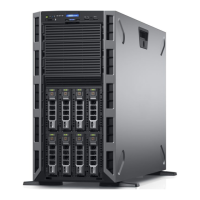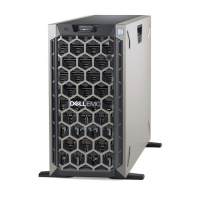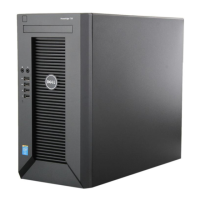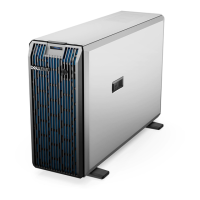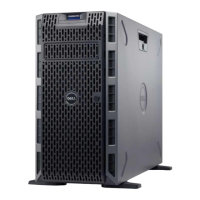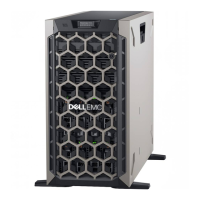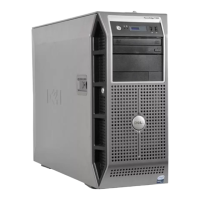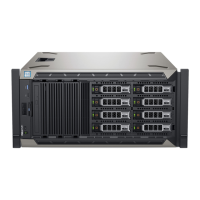Do you have a question about the Dell PowerEdge T620 and is the answer not in the manual?
Guides on selecting the appropriate boot mode (BIOS or UEFI) for system operation.
Provides steps on how to access and enter the system's setup utility.
Overview of the various configuration options available within the system setup.
Explains how to use system passwords to enhance security and protect system data.
Describes the behavior and requirements when a system setup password is active.
Information on system memory types, capacities, and installation guidelines.
Instructions for installing and removing hard drives and drive blanks.
Guidelines for installing various types of expansion cards into PCIe slots.
Covers procedures for installing or replacing system processors.
Step-by-step guide for safely removing a processor from its socket.
Step-by-step guide for safely installing a processor into its socket.
Information on the supported AC and DC power supply modules.
Instructions for safely removing an AC power supply module.
Instructions for safely installing an AC power supply module.
Guidance on wiring and connecting DC power supplies to the system.
Instructions for safely removing a DC power supply module.
Instructions for safely installing a DC power supply module.
Step-by-step instructions for safely removing the system board.
Step-by-step instructions for safely installing the system board.
Essential safety precautions to follow before troubleshooting the system.
Steps to diagnose and resolve issues related to system startup failures.
Procedures for diagnosing and resolving problems with the video subsystem.
Steps to troubleshoot issues with USB devices like keyboards and mice.
Steps to diagnose and resolve problems with serial I/O devices.
Procedures for diagnosing and resolving issues with Network Interface Cards (NICs).
Guidance on diagnosing and resolving problems with the system battery.
Steps to diagnose and resolve issues related to system power supplies.
Guidance on identifying and resolving system cooling issues.
Steps to diagnose and resolve issues related to system cooling fans.
Procedures for diagnosing and resolving problems with system memory modules.
Procedures for diagnosing and resolving issues with hard drives.
Steps to diagnose and resolve issues related to expansion cards.
Procedures for diagnosing and resolving issues with system processors.
Introduction to the embedded system diagnostics (ePSA) for pre-boot system assessment.
Instructions for disabling or clearing system and setup passwords.
Information and steps for contacting Dell support for assistance.
Guides on selecting the appropriate boot mode (BIOS or UEFI) for system operation.
Provides steps on how to access and enter the system's setup utility.
Overview of the various configuration options available within the system setup.
Explains how to use system passwords to enhance security and protect system data.
Describes the behavior and requirements when a system setup password is active.
Information on system memory types, capacities, and installation guidelines.
Instructions for installing and removing hard drives and drive blanks.
Guidelines for installing various types of expansion cards into PCIe slots.
Covers procedures for installing or replacing system processors.
Step-by-step guide for safely removing a processor from its socket.
Step-by-step guide for safely installing a processor into its socket.
Information on the supported AC and DC power supply modules.
Instructions for safely removing an AC power supply module.
Instructions for safely installing an AC power supply module.
Guidance on wiring and connecting DC power supplies to the system.
Instructions for safely removing a DC power supply module.
Instructions for safely installing a DC power supply module.
Step-by-step instructions for safely removing the system board.
Step-by-step instructions for safely installing the system board.
Essential safety precautions to follow before troubleshooting the system.
Steps to diagnose and resolve issues related to system startup failures.
Procedures for diagnosing and resolving problems with the video subsystem.
Steps to troubleshoot issues with USB devices like keyboards and mice.
Steps to diagnose and resolve problems with serial I/O devices.
Procedures for diagnosing and resolving issues with Network Interface Cards (NICs).
Guidance on diagnosing and resolving problems with the system battery.
Steps to diagnose and resolve issues related to system power supplies.
Guidance on identifying and resolving system cooling issues.
Steps to diagnose and resolve issues related to system cooling fans.
Procedures for diagnosing and resolving problems with system memory modules.
Procedures for diagnosing and resolving issues with hard drives.
Steps to diagnose and resolve issues related to expansion cards.
Procedures for diagnosing and resolving issues with system processors.
Introduction to the embedded system diagnostics (ePSA) for pre-boot system assessment.
Instructions for disabling or clearing system and setup passwords.
Information and steps for contacting Dell support for assistance.
| Storage drive size | 2.5/3.5 \ |
|---|---|
| Storage drive capacity | - GB |
| Storage drive interface | Serial ATA |
| Total installed storage capacity | - TB |
| Maximum supported storage capacity | 36 TB |
| Number of storage drives installed | - |
| Number of storage drives supported | 32 |
| Memory slots | 24 |
| Maximum RAM supported | 768 GB |
| Tcase | 70 °C |
| Bus type | QPI |
| Stepping | M1 |
| Scalability | 2S |
| Processor cache | 10 MB |
| Processor cores | 4 |
| Processor model | E5-2609 |
| System bus rate | 6.4 GT/s |
| Processor socket | LGA 2011 (Socket R) |
| Motherboard chipset | Intel C600 |
| Processor frequency | 2.4 GHz |
| Processor cache type | Smart Cache |
| Processor lithography | 32 nm |
| Processor manufacturer | Intel |
| Processor package size | 52.5 x 45.0 mm |
| Processor front side bus | - MHz |
| PCI Express slots version | 3.0 |
| Processor operating modes | 64-bit |
| ECC supported by processor | Yes |
| Thermal Design Power (TDP) | 80 W |
| Number of processors installed | 2 |
| Memory bandwidth supported by processor (max) | 34.1 GB/s |
| Maximum internal memory supported by processor | 750 GB |
| Processor ARK ID | 64588 |
| Networking features | Gigabit Ethernet |
| Compatible operating systems | Windows Server 2008 R2 SP1, x64 (Hyper-V v2), Windows HPC Server 2008, Windows Small Business Server 2011, SUSE Linux Enterprise Server, Red Hat Enterprise Linux, Optional Embedded Hypervisors: Citrix XenServer/VMware vSphere |
| Chassis type | Rack (5U) |
| Product color | Silver |
| Sustainability certificates | ENERGY STAR |
| Embedded options available | No |
| Maximum number of PCI Express lanes | 40 |
| Memory types supported by processor | DDR3-SDRAM |
| Memory channels supported by processor | Quad |
| Intel Identity Protection Technology version | 0.00 |

